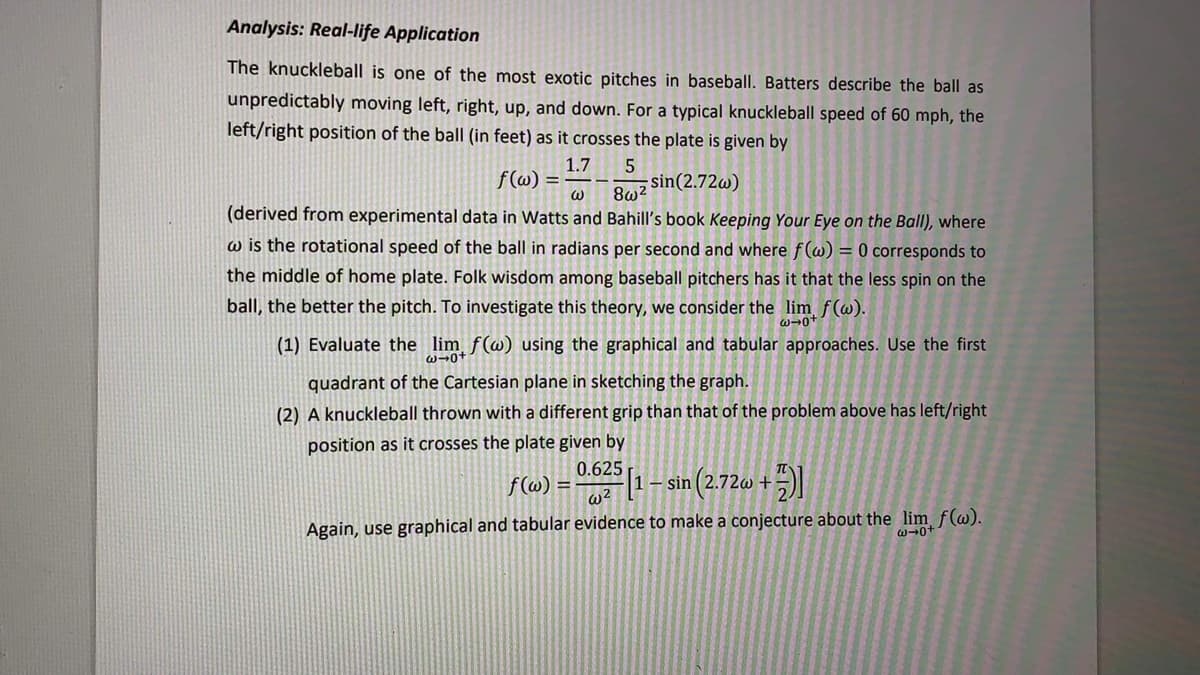The knuckleball is one of the most exotic pitches in baseball. Batters describe the ball as unpredictably moving left, right, up, and down. For a typical knuckleball speed of 60 mph, the left/right position of the ball (in feet) as it crosses the plate is given by 1.7 f(w) = sin(2.72w) 8w2 %3D (derived from experimental data in Watts and Bahill's book Keeping Your Eye on the BallI), where w is the rotational speed of the ball in radians per second and where f(@) = 0 corresponds to the middle of home plate. Folk wisdom among baseball pitchers has it that the less spin on the ball, the better the pitch. To investigate this theory, we consider the lim f(w). (1) Evaluate the lim f(@) using the graphical and tabular approaches. Use the first quadrant of the Cartesian plane in sketching the graph. (2) A knuckleball thrown with a different grip than that of the problem above has left/right position as it crosses the plate given by
The knuckleball is one of the most exotic pitches in baseball. Batters describe the ball as unpredictably moving left, right, up, and down. For a typical knuckleball speed of 60 mph, the left/right position of the ball (in feet) as it crosses the plate is given by 1.7 f(w) = sin(2.72w) 8w2 %3D (derived from experimental data in Watts and Bahill's book Keeping Your Eye on the BallI), where w is the rotational speed of the ball in radians per second and where f(@) = 0 corresponds to the middle of home plate. Folk wisdom among baseball pitchers has it that the less spin on the ball, the better the pitch. To investigate this theory, we consider the lim f(w). (1) Evaluate the lim f(@) using the graphical and tabular approaches. Use the first quadrant of the Cartesian plane in sketching the graph. (2) A knuckleball thrown with a different grip than that of the problem above has left/right position as it crosses the plate given by
Algebra & Trigonometry with Analytic Geometry
13th Edition
ISBN:9781133382119
Author:Swokowski
Publisher:Swokowski
Chapter6: The Trigonometric Functions
Section6.7: Applied Problems
Problem 56E
Related questions
Question

Transcribed Image Text:Analysis: Real-life Application
The knuckleball is one of the most exotic pitches in baseball. Batters describe the ball as
unpredictably moving left, right, up, and down. For a typical knuckleball speed of 60 mph, the
left/right position of the ball (in feet) as it crosses the plate is given by
1.7
f(@) =
sin(2.72w)
8w?
(derived from experimental data in Watts and Bahill's book Keeping Your Eye on the BallI), where
w is the rotational speed of the ball in radians per second and where f(@) = 0 corresponds to
the middle of home plate. Folk wisdom among baseball pitchers has it that the less spin on the
ball, the better the pitch. To investigate this theory, we consider the lim f(w).
(1) Evaluate the lim f(@) using the graphical and tabular approaches. Use the first
quadrant of the Cartesian plane in sketching the graph.
(2) A knuckleball thrown with a different grip than that of the problem above has left/right
position as it crosses the plate given by
0.625
f(w) = -
[1 – sın (2.72w + )|
– sin
Again, use graphical and tabular evidence to make a conjecture about the lim f(w).
Expert Solution
This question has been solved!
Explore an expertly crafted, step-by-step solution for a thorough understanding of key concepts.
This is a popular solution!
Trending now
This is a popular solution!
Step by step
Solved in 4 steps with 2 images

Recommended textbooks for you

Algebra & Trigonometry with Analytic Geometry
Algebra
ISBN:
9781133382119
Author:
Swokowski
Publisher:
Cengage

Algebra & Trigonometry with Analytic Geometry
Algebra
ISBN:
9781133382119
Author:
Swokowski
Publisher:
Cengage